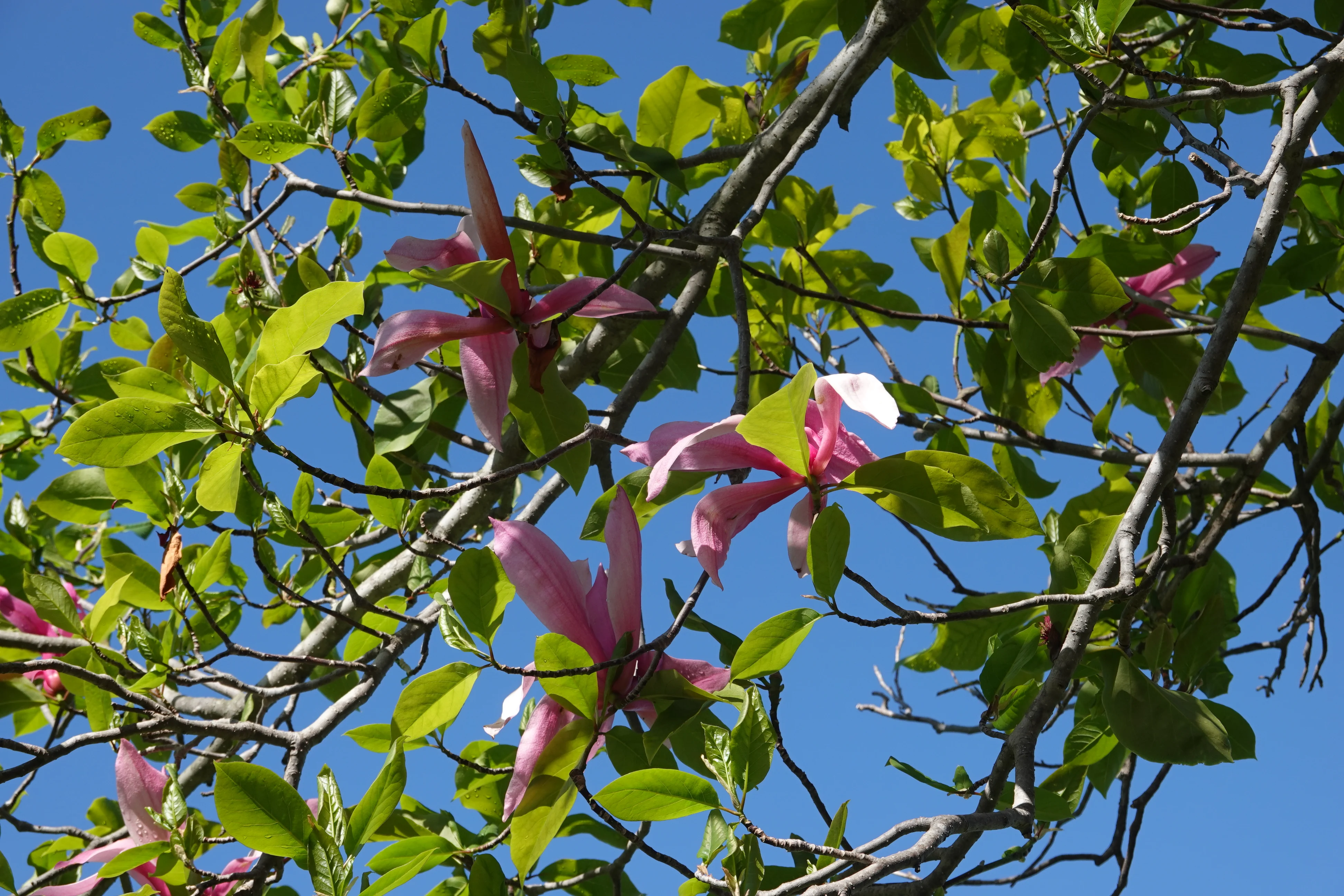Magnolia liliiflora is native to southwest China (in Sichuan and Yunnan), but cultivated for centuries elsewhere in China and also Japan. Variously known by many names, including Mulan magnolia, purple magnolia, red magnolia, lily magnolia, tulip magnolia and woody-orchid, it was first introduced to English-speaking countries from cultivated Japanese origins, and is thus also sometimes called Japanese magnolia, though it is not native to Japan. It blooms profusely in early spring with large pink to purple goblet- or lily-shaped flowers, before the leaf buds open.
紫玉蘭原產於中國西南部(四川和雲南),但在中國其他地區以及日本已有數百年的栽培歷史。它有許多不同的名字,包括木蘭、紫木蘭、紅木蘭、百合木蘭、鬱金香木蘭、木本蘭花、紫玉蘭(河南),辛夷(江蘇),木筆(花鏡),杜蘭『本經』,木蘭、桂蘭『廣雅』,杜蘭『別錄』,黃心樹『綱目』,房木、春花,它最早是從日本栽培引入英語國家的,因此有時也被稱為日本木蘭,儘管它並非原產於日本。它在早春時節,在葉芽開放之前,盛開著大朵大朵的從粉紅色到紫色的高腳杯形或百合形花朵。
Here are some varieties and hybrids derived from the Magnolia liliiflora/Mulan magnolia:
以下是由紫玉蘭衍生的一些變種及雜交品種:



Notes for Magnolia liliiflora ‘Nigra’ 筆記
- Magnolia liliiflora ‘Nigra’ is a spreading deciduous shrub with deep lustrous green leaves and slightly fragrant, dark reddish-purple flowers in late spring. Narrowly tulip-shaped, the upright blossoms, up to 5 in. long, count 9-18 tepals, purple-red on the outside, opening to reveal pale purple insides.
- Introduced from Japan in 1861, this dwarf Magnolia makes an elegant, small specimen tree and ideal focal point.
- Winner of the prestigious Award of Garden Merit of the Royal Horticultural Society.







Notes for Magnolia ‘Raspberry Ice’ 筆記
- It is a cross between M. liliiflora x M. veitchii and was found by Gresham.
- Has a long flowering period and large 16 - 24 cm, raspberry-pink and white flowers with a violet shading at the base.






Notes for Magnolia ‘Spectrum’ 筆記
- ‘Spectrum’ is a cross between M. liliiflora ‘Nigra’ x M. sprengeri var. sprengeri ‘Diva’. It was raised by William Kosar at the U.S National Arboretum in 1963. Received the Royal Horticultural Society’s Award of Garden Merit in 2012.
- The flowers are huge, tulip-shaped. Slightly fragrant. They are deep reddish-pink on the outside and creamy white within.




Notes for Magnolia 'Royal Crown' 筆記
- Magnolia 'Royal Crown' is of the first "Gresham hybrids" introduced by D. Todd Gresham in the 1960's, this one a hybrid of M. ×veitchii and M. liliiflora. It's name refers to the reflexed outer tepals, giving the flower the overall impression of a crown.
- Blooms open in late winter in the southern part of its range to early spring in the northern part of its range before the leaves emerge. Flower petals are pink on the outside and white inside.
Notes for Magnolia liliiflora/Mulan magnolia 紫玉蘭筆記
- Magnolia liliiflora is native to southwest China (in Sichuan and Yunnan), but cultivated for centuries elsewhere in China and also Japan. Variously known by many names, including Mulan magnolia, purple magnolia, red magnolia, lily magnolia, tulip magnolia and woody-orchid, it was first introduced to English-speaking countries from cultivated Japanese origins, and is thus also sometimes called Japanese magnolia, though it is not native to Japan.
- It blooms profusely in early spring with large pink to purple goblet- or lily-shaped flowers, before the leaf buds open.
- This species is one of the parents of the popular hybrid saucer magnolia, M. × soulangeana, the other parent being the Yulan magnolia, M. denudata.
- The cultivar 'Nigra', with flowers much deeper in colour than the species, has gained the Royal Horticultural Society's Award of Garden Merit.
- The bark, leaves and flowers of Magnolia liliiflora can be used to extract essences, make high-end spices, beverages and foods, and can also be used to prepare soaps and cosmetics, and have high economic value.
- Magnolia liliiflora has a long history in China and was described as early as in Qu Yuan's Warring States Period. The bark, leaves and buds of Magnolia liliiflora can all be used as medicine. The buds are called Biod Magnolia Bud and are a traditional Chinese medicinal material. They are picked and dried 1-2 weeks before flowering. They have a fragrant smell and spicy taste. The main components of the volatile oil are citral, eugenol and eucalyptus oil. They can be used dry or fresh. They have antihypertensive, analgesic, astringent and bactericidal effects. They can treat pneumonia, sores, rhinitis, headaches and other symptoms. They have the effects of lightening the body, improving eyesight and prolonging life. "Shennong's Herbal Classic" lists it as a top-grade medicinal material, and "Ming Yi Bie Lu" also records its effects. The flower buds of Magnolia plants contain a lot of flavonoids, which have the effects of dilating blood vessels, lowering blood pressure, inhibiting platelet aggregation and thrombosis. Among them, the content of such substances in Magnolia liliiflora buds is one of the highest.
- 紫玉蘭原產於中國西南部(四川和雲南),但在中國其他地區以及日本已有數百年的栽培歷史。它有許多不同的名字,包括木蘭、紫木蘭、紅木蘭、百合木蘭、鬱金香木蘭、木本蘭花、紫玉蘭(河南),辛夷(江蘇),木筆(花鏡),杜蘭『本經』,木蘭、桂蘭『廣雅』,杜蘭『別錄』,黃心樹『綱目』,房木、春花,它最早是從日本栽培引入英語國家的,因此有時也被稱為日本木蘭,儘管它並非原產於日本。
- 它在早春時節,在葉芽開放之前,盛開著大朵大朵的從粉紅色到紫色的高腳杯形或百合形花朵。
- 它是流行的雜交二喬木蘭(M.×soulangeana)的親本之一,另一個親本是玉蘭(M. denudata)。
- 栽培品種 ‘Nigra’ 的花色比其他品種深得多,並獲得了皇家園藝學會的花園功績獎。
- 紫玉蘭樹皮、葉、花可用於提取香精,製作高檔香料、飲品和食品,也可用於調配香皂和化妝品,有很高的經濟價值。
- 紫玉蘭在中國有著悠久的歷史,早在戰國時期屈原的《九歌》和《九章》中就有描述。紫玉蘭樹皮、葉、花蕾均可入藥,花蕾入藥稱“辛夷”,乃中藥材,開花前 1-2 週採摘晾乾即得,氣味芳香,味辛辣,揮髮油主要成分是檸檬醛、丁香油酚、桉油精,可干用或鮮用,具有降壓、鎮疼、收斂、殺菌等功效,可治肺炎、瘡毒、鼻炎、頭疼等症,有輕身明目,延年益壽的功效,《神農本草經》將之列為上品藥材,《名醫別錄》也記載了其功效。木蘭屬植物的花蕾均含有較多的黃酮類物質,有擴張血管、降血壓、抑制血小板聚集和血栓形成的作用,而其中以紫玉蘭花蕾中此類物質的含量為最高之一。
References 參考資料
- Wikipedia: Magnolia liliiflora
- 認識植物: 紫玉蘭
- Missouri Botanical Garden: Magnolia lilliflora 'Nigra'
- Gardenia Creating Gardens: Magnolia lilliflora 'Nigra'
- World Plants.ca: Magnolia 'Raspberry Ice' (Raspberry Ice Magnolia)
- Gardenia: Magnolia ‘Spectrum’
- Frank P Matthews: Magnolia ‘Spectrum’
- Magnolia Society International: facebook post for Royal Crown
Plants Posts 植物的帖子
Comments